The Cambridge History of Japan, Vol. 4: Early Modern Japan
Подождите немного. Документ загружается.

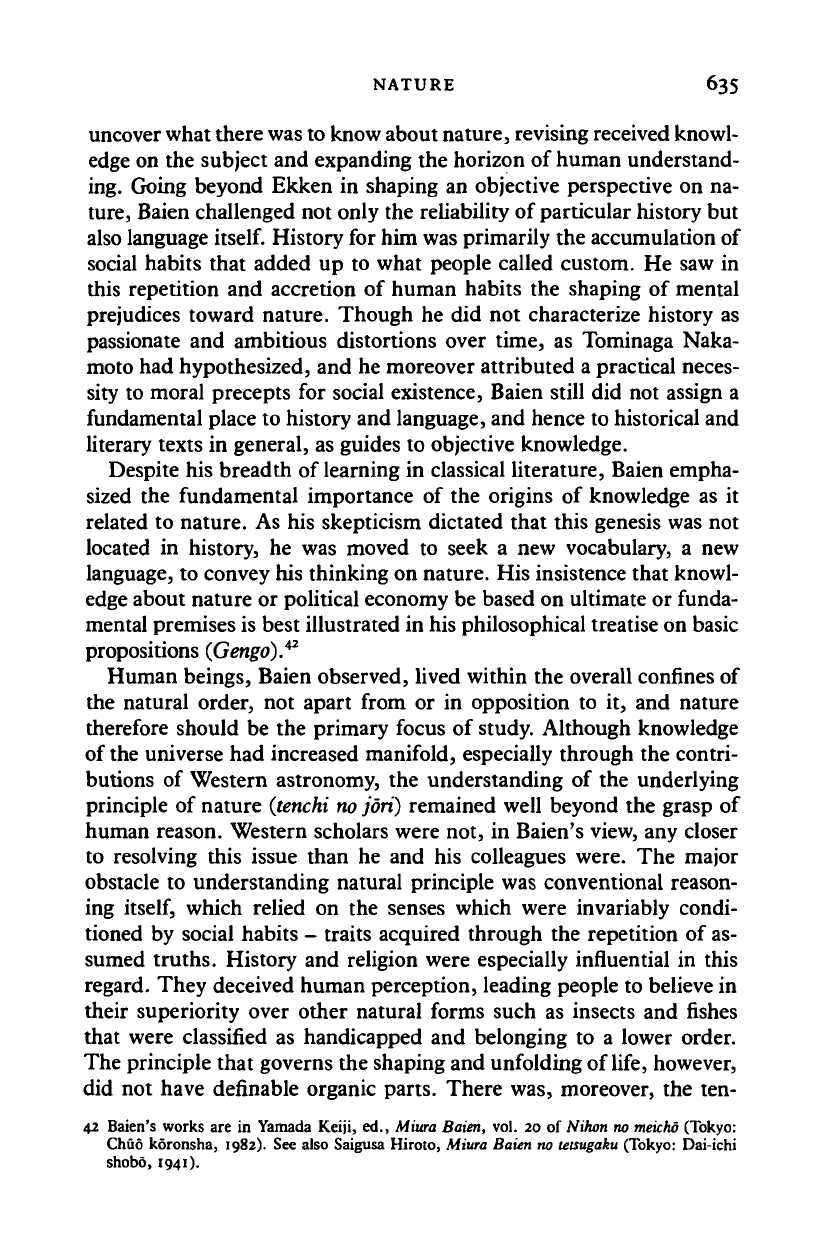
NATURE
635
uncover what there
was
to know about nature, revising received knowl-
edge
on the
subject
and
expanding
the
horizon
of
human understand-
ing. Going beyond Ekken
in
shaping
an
objective perspective
on na-
ture,
Baien challenged
not
only
the
reliability
of
particular history
but
also language
itself.
History
for
him was primarily
the
accumulation of
social habits that added
up to
what people called custom.
He saw in
this repetition
and
accretion
of
human habits
the
shaping
of
mental
prejudices toward nature. Though
he did not
characterize history
as
passionate
and
ambitious distortions over time,
as
Tominaga Naka-
moto
had
hypothesized,
and he
moreover attributed
a
practical neces-
sity
to
moral precepts
for
social existence, Baien still
did not
assign
a
fundamental place
to
history
and
language,
and
hence
to
historical
and
literary texts
in
general,
as
guides
to
objective knowledge.
Despite
his
breadth
of
learning
in
classical literature, Baien empha-
sized
the
fundamental importance
of the
origins
of
knowledge
as it
related
to
nature.
As his
skepticism dictated that this genesis
was not
located
in
history,
he was
moved
to
seek
a new
vocabulary,
a new
language,
to
convey his thinking
on
nature. His insistence that knowl-
edge about nature
or
political economy
be
based
on
ultimate
or
funda-
mental premises
is
best illustrated
in
his philosophical treatise
on
basic
propositions
(Gengo).
42
Human beings, Baien observed, lived within
the
overall confines
of
the natural order,
not
apart from
or in
opposition
to it, and
nature
therefore should
be the
primary focus
of
study. Although knowledge
of the universe
had
increased manifold, especially through
the
contri-
butions
of
Western astronomy,
the
understanding
of the
underlying
principle
of
nature
(tenchi no jori)
remained well beyond
the
grasp
of
human reason. Western scholars were
not, in
Baien's view,
any
closer
to resolving this issue than
he and his
colleagues were.
The
major
obstacle
to
understanding natural principle
was
conventional reason-
ing
itself,
which relied
on the
senses which were invariably condi-
tioned
by
social habits
-
traits acquired through
the
repetition
of
as-
sumed truths. History
and
religion were especially influential
in
this
regard. They deceived human perception, leading people
to
believe
in
their superiority over other natural forms such
as
insects
and
fishes
that were classified
as
handicapped
and
belonging
to a
lower order.
The principle that governs
the
shaping
and
unfolding of
life,
however,
did
not
have definable organic parts. There
was,
moreover,
the ten-
42 Baien's works
are in
Yamada Keiji,
ed.,
Miura Baien,
vol. 20 of
Nihon
no
meicho
(Tokyo:
Chuo koronsha, 1982).
See
also Saigusa Hiroto, Miura Baien
no
leisugaku
(Tokyo: Dai-ichi
shobo, 1941).
Cambridge Histories Online © Cambridge University Press, 2008
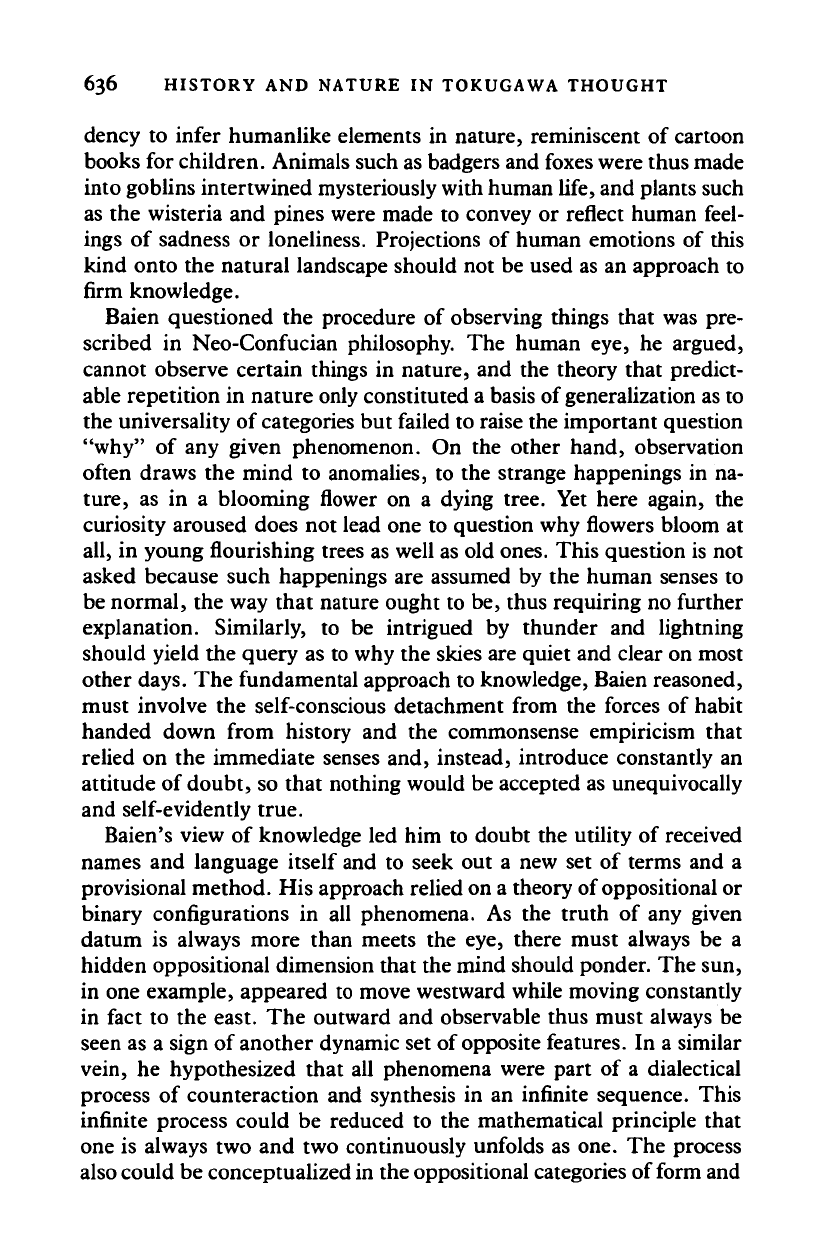
636 HISTORY AND NATURE IN TOKUGAWA THOUGHT
dency to infer humanlike elements in nature, reminiscent of cartoon
books for children. Animals such as badgers and foxes were thus made
into goblins intertwined mysteriously with human life, and plants such
as the wisteria and pines were made to convey or reflect human feel-
ings of sadness or loneliness. Projections of human emotions of this
kind onto the natural landscape should not be used as an approach to
firm knowledge.
Baien questioned the procedure of observing things that was pre-
scribed in Neo-Confucian philosophy. The human eye, he argued,
cannot observe certain things in nature, and the theory that predict-
able repetition in nature only constituted a basis of generalization as to
the universality of categories but failed to raise the important question
"why" of any given phenomenon. On the other hand, observation
often draws the mind to anomalies, to the strange happenings in na-
ture,
as in a blooming flower on a dying tree. Yet here again, the
curiosity aroused does not lead one to question why flowers bloom at
all,
in young flourishing trees as well as old ones. This question is not
asked because such happenings are assumed by the human senses to
be normal, the way that nature ought to be, thus requiring no further
explanation. Similarly, to be intrigued by thunder and lightning
should yield the query as to why the skies are quiet and clear on most
other days. The fundamental approach to knowledge, Baien reasoned,
must involve the self-conscious detachment from the forces of habit
handed down from history and the commonsense empiricism that
relied on the immediate senses and, instead, introduce constantly an
attitude of doubt, so that nothing would be accepted as unequivocally
and self-evidently true.
Baien's view of knowledge led him to doubt the utility of received
names and language itself and to seek out a new set of terms and a
provisional method. His approach relied on a theory of oppositional or
binary configurations in all phenomena. As the truth of any given
datum is always more than meets the eye, there must always be a
hidden oppositional dimension that the mind should ponder. The sun,
in one example, appeared to move westward while moving constantly
in fact to the east. The outward and observable thus must always be
seen as a sign of another dynamic set of opposite features. In a similar
vein, he hypothesized that all phenomena were part of a dialectical
process of counteraction and synthesis in an infinite sequence. This
infinite process could be reduced to the mathematical principle that
one is always two and two continuously unfolds as one. The process
also could be conceptualized in the oppositional categories of form and
Cambridge Histories Online © Cambridge University Press, 2008
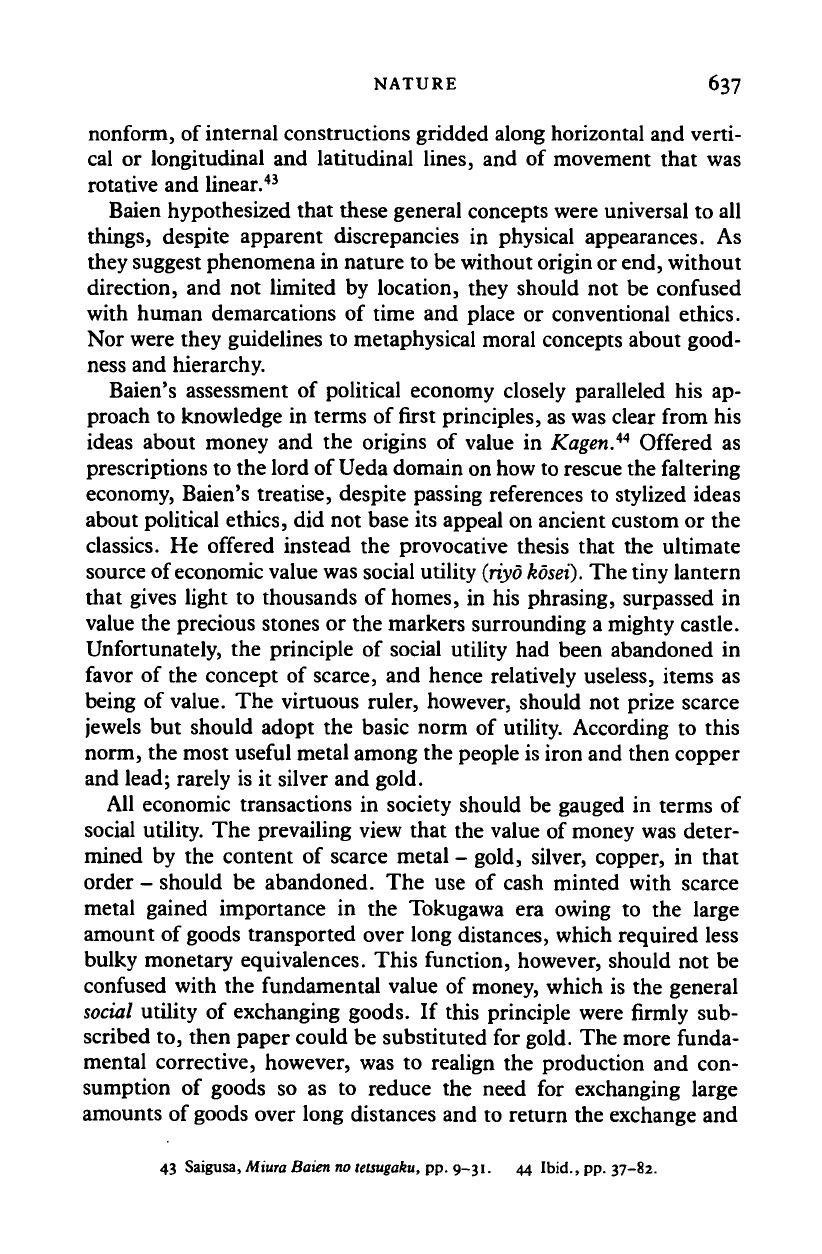
NATURE 637
nonform, of internal constructions gridded along horizontal and verti-
cal or longitudinal and latitudinal lines, and of movement that was
rotative and linear.
43
Baien hypothesized that these general concepts were universal to all
things, despite apparent discrepancies in physical appearances. As
they suggest phenomena in nature to be without origin or end, without
direction, and not limited by location, they should not be confused
with human demarcations of time and place or conventional ethics.
Nor were they guidelines to metaphysical moral concepts about good-
ness and hierarchy.
Baien's assessment of political economy closely paralleled his ap-
proach to knowledge in terms of first principles, as was clear from his
ideas about money and the origins of value in Kagen.
44
Offered as
prescriptions to the lord of Ueda domain on how to rescue the faltering
economy, Baien's treatise, despite passing references to stylized ideas
about political ethics, did not base its appeal on ancient custom or the
classics. He offered instead the provocative thesis that the ultimate
source of economic value was social utility
(riyo
kosei).
The tiny lantern
that gives light to thousands of homes, in his phrasing, surpassed in
value the precious stones or the markers surrounding a mighty castle.
Unfortunately, the principle of social utility had been abandoned in
favor of the concept of scarce, and hence relatively useless, items as
being of value. The virtuous ruler, however, should not prize scarce
jewels but should adopt the basic norm of utility. According to this
norm, the most useful metal among the people is iron and then copper
and lead; rarely is it silver and gold.
All economic transactions in society should be gauged in terms of
social utility. The prevailing view that the value of money was deter-
mined by the content of scarce metal - gold, silver, copper, in that
order - should be abandoned. The use of cash minted with scarce
metal gained importance in the Tokugawa era owing to the large
amount of goods transported over long distances, which required less
bulky monetary equivalences. This function, however, should not be
confused with the fundamental value of money, which is the general
social
utility of exchanging goods. If this principle were firmly sub-
scribed to, then paper could be substituted for gold. The more funda-
mental corrective, however, was to realign the production and con-
sumption of goods so as to reduce the need for exchanging large
amounts of goods over long distances and to return the exchange and
43 Saigusa, Mima Baien no
tetsugaku,
pp. 9-31. 44 Ibid., pp. 37-82.
Cambridge Histories Online © Cambridge University Press, 2008
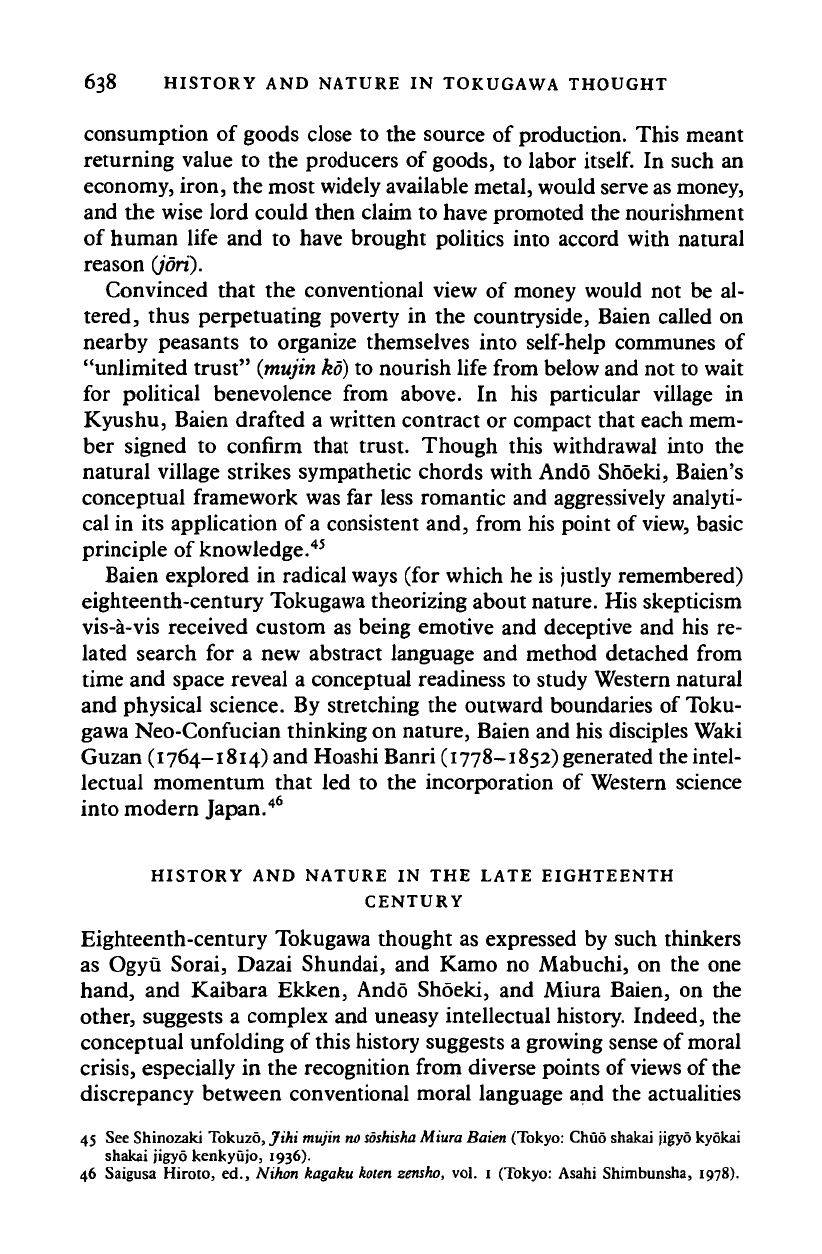
638 HISTORY AND NATURE IN TOKUGAWA THOUGHT
consumption of goods close to the source of production. This meant
returning value to the producers of goods, to labor
itself.
In such an
economy, iron, the most widely available metal, would serve as money,
and the wise lord could then claim to have promoted the nourishment
of human life and to have brought politics into accord with natural
reason (jori).
Convinced that the conventional view of money would not be al-
tered, thus perpetuating poverty in the countryside, Baien called on
nearby peasants to organize themselves into self-help communes of
"unlimited trust"
{mujin ko)
to nourish life from below and not to wait
for political benevolence from above. In his particular village in
Kyushu, Baien drafted a written contract or compact that each mem-
ber signed to confirm that trust. Though this withdrawal into the
natural village strikes sympathetic chords with Ando Shdeki, Baien's
conceptual framework was far less romantic and aggressively analyti-
cal in its application of
a
consistent and, from his point of
view,
basic
principle of knowledge.
45
Baien explored in radical ways (for which he is justly remembered)
eighteenth-century Tokugawa theorizing about nature. His skepticism
vis-a-vis received custom as being emotive and deceptive and his re-
lated search for a new abstract language and method detached from
time and space reveal a conceptual readiness to study Western natural
and physical science. By stretching the outward boundaries of Toku-
gawa Neo-Confucian thinking on nature, Baien and his disciples Waki
Guzan (1764-1814) and Hoashi Banri (1778-1852) generated the intel-
lectual momentum that led to the incorporation of Western science
into modern Japan.
46
HISTORY AND NATURE IN THE LATE EIGHTEENTH
CENTURY
Eighteenth-century Tokugawa thought as expressed by such thinkers
as Ogyu Sorai, Dazai Shundai, and Kamo no Mabuchi, on the one
hand, and Kaibara Ekken, Ando Shdeki, and Miura Baien, on the
other, suggests a complex and uneasy intellectual history. Indeed, the
conceptual unfolding of this history suggests a growing sense of moral
crisis,
especially in the recognition from diverse points of
views
of the
discrepancy between conventional moral language and the actualities
45 See Shinozaki Tokuzd, Jihi mujin no
soshisha
Miura Baien (Tokyo: Chuo shakai jigyo kyokai
shakai jigyo kenkyu
jo,
1936).
46 Saigusa Hiroto, ed., Nihon kagaku koien zensho, vol. 1 (Tokyo: Asahi Shimbunsha, 1978).
Cambridge Histories Online © Cambridge University Press, 2008
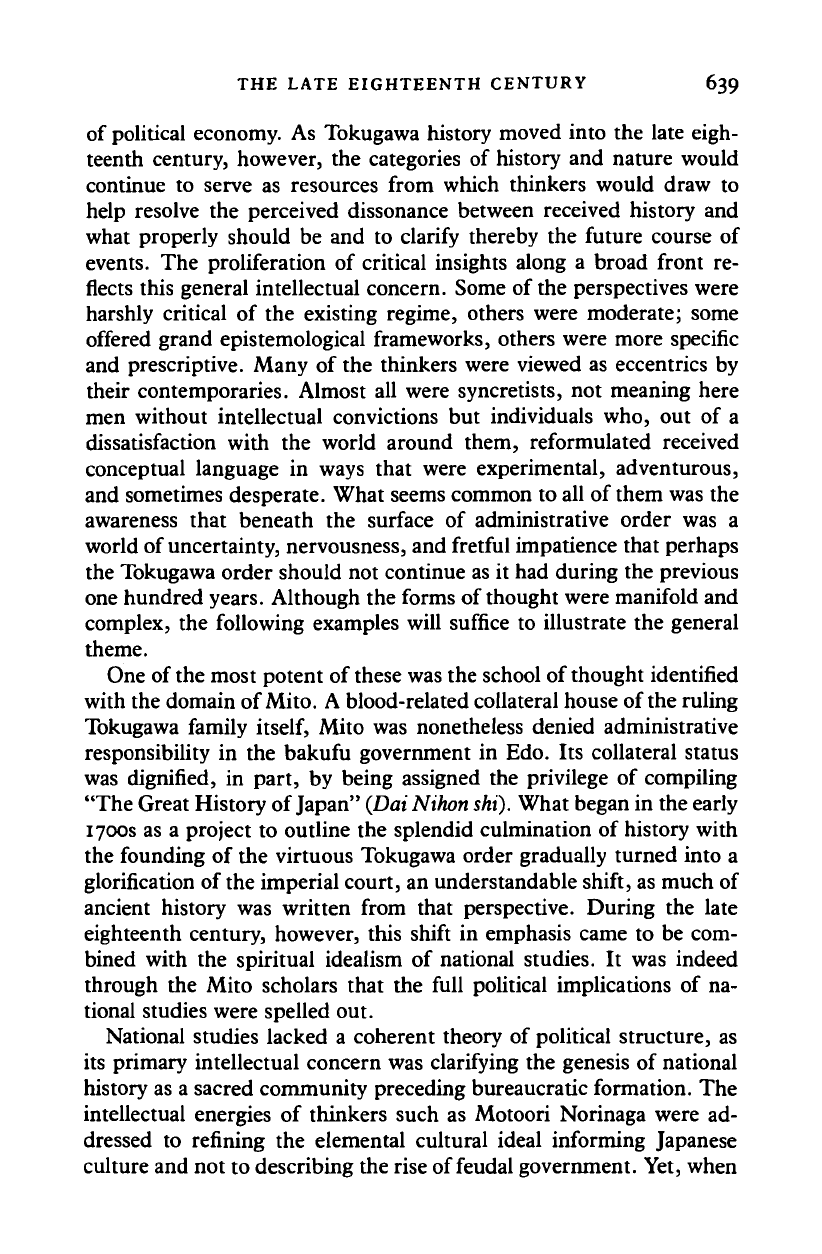
THE LATE EIGHTEENTH CENTURY 639
of political economy. As Tokugawa history moved into the late eigh-
teenth century, however, the categories of history and nature would
continue to serve as resources from which thinkers would draw to
help resolve the perceived dissonance between received history and
what properly should be and to clarify thereby the future course of
events. The proliferation of critical insights along a broad front re-
flects this general intellectual concern. Some of the perspectives were
harshly critical of the existing regime, others were moderate; some
offered grand epistemological frameworks, others were more specific
and prescriptive. Many of the thinkers were viewed as eccentrics by
their contemporaries. Almost all were syncretists, not meaning here
men without intellectual convictions but individuals who, out of a
dissatisfaction with the world around them, reformulated received
conceptual language in ways that were experimental, adventurous,
and sometimes desperate. What seems common to all of them was the
awareness that beneath the surface of administrative order was a
world of uncertainty, nervousness, and fretful impatience that perhaps
the Tokugawa order should not continue as it had during the previous
one hundred years. Although the forms of thought were manifold and
complex, the following examples will suffice to illustrate the general
theme.
One of the most potent of these was the school of thought identified
with the domain of
Mito.
A blood-related collateral house of the ruling
Tokugawa family
itself,
Mito was nonetheless denied administrative
responsibility in the bakufu government in Edo. Its collateral status
was dignified, in part, by being assigned the privilege of compiling
"The Great History of Japan"
(Dai Nihon
shi).
What began in the early
1700s as a project to outline the splendid culmination of history with
the founding of the virtuous Tokugawa order gradually turned into a
glorification of the imperial court, an understandable shift, as much of
ancient history was written from that perspective. During the late
eighteenth century, however, this shift in emphasis came to be com-
bined with the spiritual idealism of national studies. It was indeed
through the Mito scholars that the full political implications of na-
tional studies were spelled out.
National studies lacked a coherent theory of political structure, as
its primary intellectual concern was clarifying the genesis of national
history as a sacred community preceding bureaucratic formation. The
intellectual energies of thinkers such as Motoori Norinaga were ad-
dressed to refining the elemental cultural ideal informing Japanese
culture and not to describing the rise of feudal government. Yet, when
Cambridge Histories Online © Cambridge University Press, 2008
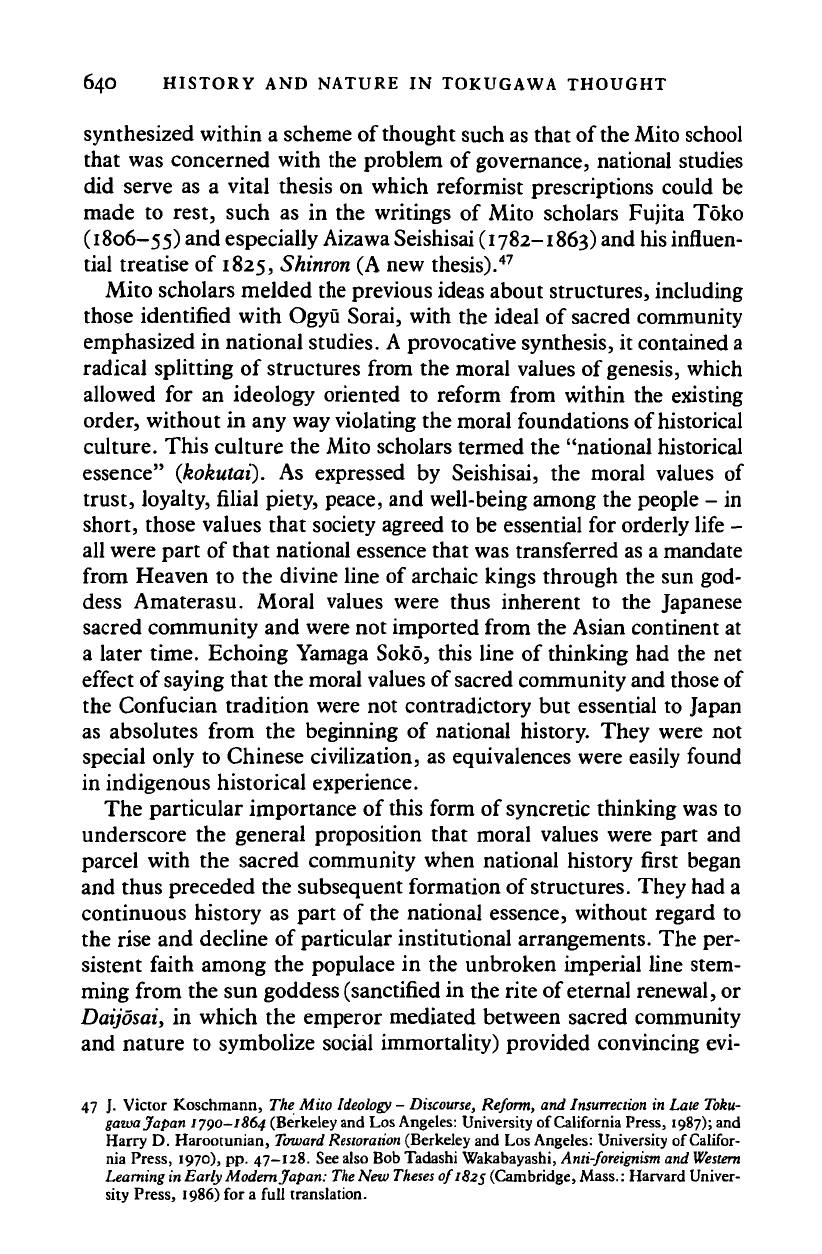
640 HISTORY AND NATURE IN TOKUGAWA THOUGHT
synthesized within a scheme of thought such as that of the Mito school
that was concerned with the problem of governance, national studies
did serve as a vital thesis on which reformist prescriptions could be
made to rest, such as in the writings of Mito scholars Fujita Toko
(1806-55) and especially Aizawa Seishisai (1782-1863) and his influen-
tial treatise of 1825, Shimon (A new thesis).
47
Mito scholars melded the previous ideas about structures, including
those identified with Ogyu Sorai, with the ideal of sacred community
emphasized in national studies. A provocative synthesis, it contained a
radical splitting of structures from the moral values of
genesis,
which
allowed for an ideology oriented to reform from within the existing
order, without in any way violating the moral foundations of historical
culture. This culture the Mito scholars termed the "national historical
essence" (kokutai). As expressed by Seishisai, the moral values of
trust, loyalty, filial piety, peace, and well-being among the people - in
short, those values that society agreed to be essential for orderly life -
all were part of that national essence that was transferred as a mandate
from Heaven to the divine line of archaic kings through the sun god-
dess Amaterasu. Moral values were thus inherent to the Japanese
sacred community and were not imported from the Asian continent at
a later time. Echoing Yamaga Soko, this line of thinking had the net
effect of saying that the moral values of sacred community and those of
the Confucian tradition were not contradictory but essential to Japan
as absolutes from the beginning of national history. They were not
special only to Chinese civilization, as equivalences were easily found
in indigenous historical experience.
The particular importance of this form of syncretic thinking was to
underscore the general proposition that moral values were part and
parcel with the sacred community when national history first began
and thus preceded the subsequent formation of
structures.
They had a
continuous history as part of the national essence, without regard to
the rise and decline of particular institutional arrangements. The per-
sistent faith among the populace in the unbroken imperial line stem-
ming from the sun goddess (sanctified in the rite of eternal renewal, or
Daijosai, in which the emperor mediated between sacred community
and nature to symbolize social immortality) provided convincing evi-
47 J. Victor Koschmann, The Mito Ideology - Discourse, Reform, and Insurrection in Late Toku-
gawa Japan 1790-1864 (Berkeley and Los Angeles: University of California Press, 1987); and
Harry D. Harootunian, Toward
Restoration
(Berkeley and Los Angeles: University of Califor-
nia Press, 1970), pp. 47-128. See also Bob Tadashi Wakabayashi, Anti-foreignism and
Western
Learning in Early Modem Japan:
The
New
Theses
of 182s (Cambridge, Mass.: Harvard Univer-
sity Press, 1986) for a full translation.
Cambridge Histories Online © Cambridge University Press, 2008
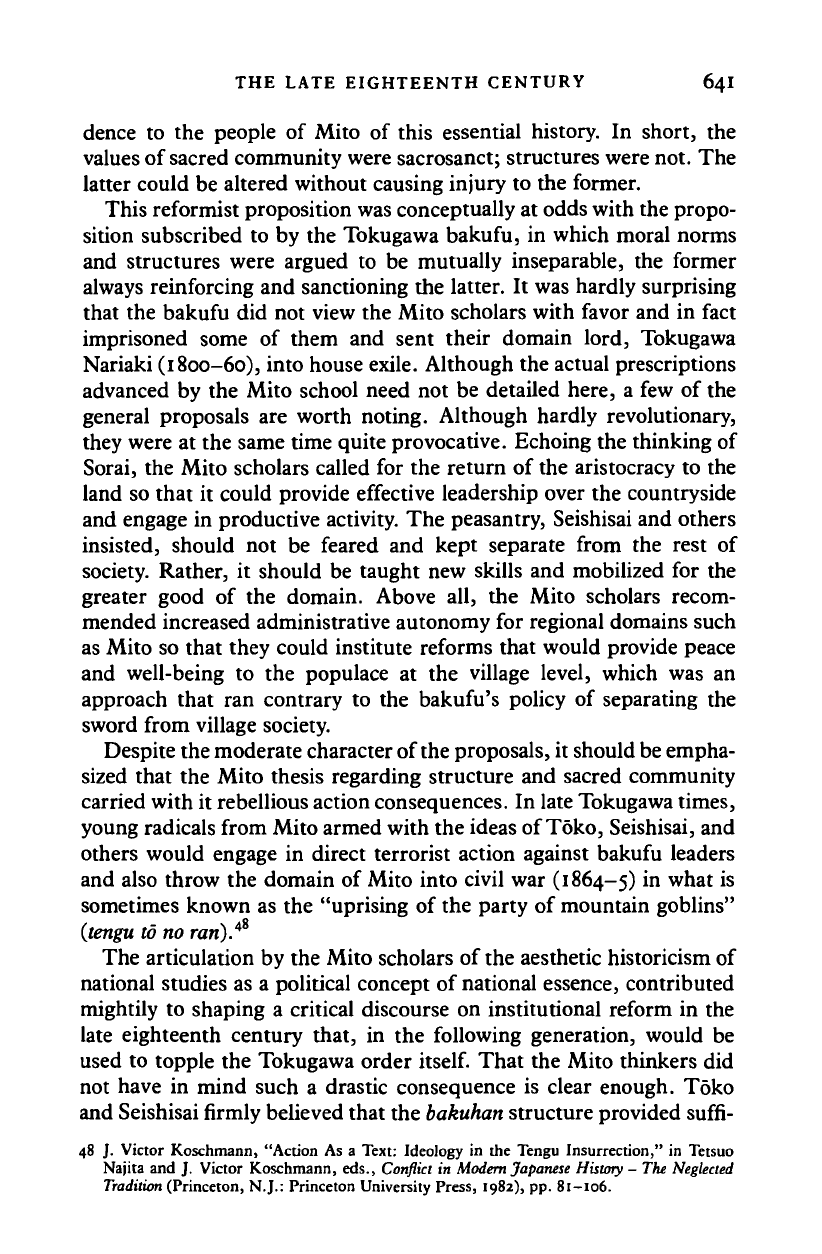
THE LATE EIGHTEENTH CENTURY 64I
dence to the people of Mi to of this essential history. In short, the
values of sacred community were sacrosanct; structures were not. The
latter could be altered without causing injury to the former.
This reformist proposition was conceptually at odds with the propo-
sition subscribed to by the Tokugawa bakufu, in which moral norms
and structures were argued to be mutually inseparable, the former
always reinforcing and sanctioning the latter. It was hardly surprising
that the bakufu did not view the Mito scholars with favor and in fact
imprisoned some of them and sent their domain lord, Tokugawa
Nariaki (1800-60), into house exile. Although the actual prescriptions
advanced by the Mito school need not be detailed here, a few of the
general proposals are worth noting. Although hardly revolutionary,
they were at the same time quite provocative. Echoing the thinking of
Sorai, the Mito scholars called for the return of the aristocracy to the
land so that it could provide effective leadership over the countryside
and engage in productive activity. The peasantry, Seishisai and others
insisted, should not be feared and kept separate from the rest of
society. Rather, it should be taught new skills and mobilized for the
greater good of the domain. Above all, the Mito scholars recom-
mended increased administrative autonomy for regional domains such
as Mito so that they could institute reforms that would provide peace
and well-being to the populace at the village level, which was an
approach that ran contrary to the bakufu's policy of separating the
sword from village society.
Despite the moderate character of the proposals, it should be empha-
sized that the Mito thesis regarding structure and sacred community
carried with it rebellious action consequences. In late Tokugawa times,
young radicals from Mito armed with the ideas of
Toko,
Seishisai, and
others would engage in direct terrorist action against bakufu leaders
and also throw the domain of Mito into civil war (1864-5)
m
what is
sometimes known as the "uprising of the party of mountain goblins"
(tengu to no
ran).
4
*
The articulation by the Mito scholars of the aesthetic historicism of
national studies as a political concept of national essence, contributed
mightily to shaping a critical discourse on institutional reform in the
late eighteenth century that, in the following generation, would be
used to topple the Tokugawa order
itself.
That the Mito thinkers did
not have in mind such a drastic consequence is clear enough. Toko
and Seishisai firmly believed that the
bakuhan
structure provided suffi-
48 J. Victor Koschmann, "Action As a Text: Ideology in the Tengu Insurrection," in Tetsuo
Najita and J. Victor Koschmann, eds., Conflict in Modern Japanese History - The
Neglected
Tradition (Princeton, N.J.: Princeton University Press, 1982), pp. 81-106.
Cambridge Histories Online © Cambridge University Press, 2008
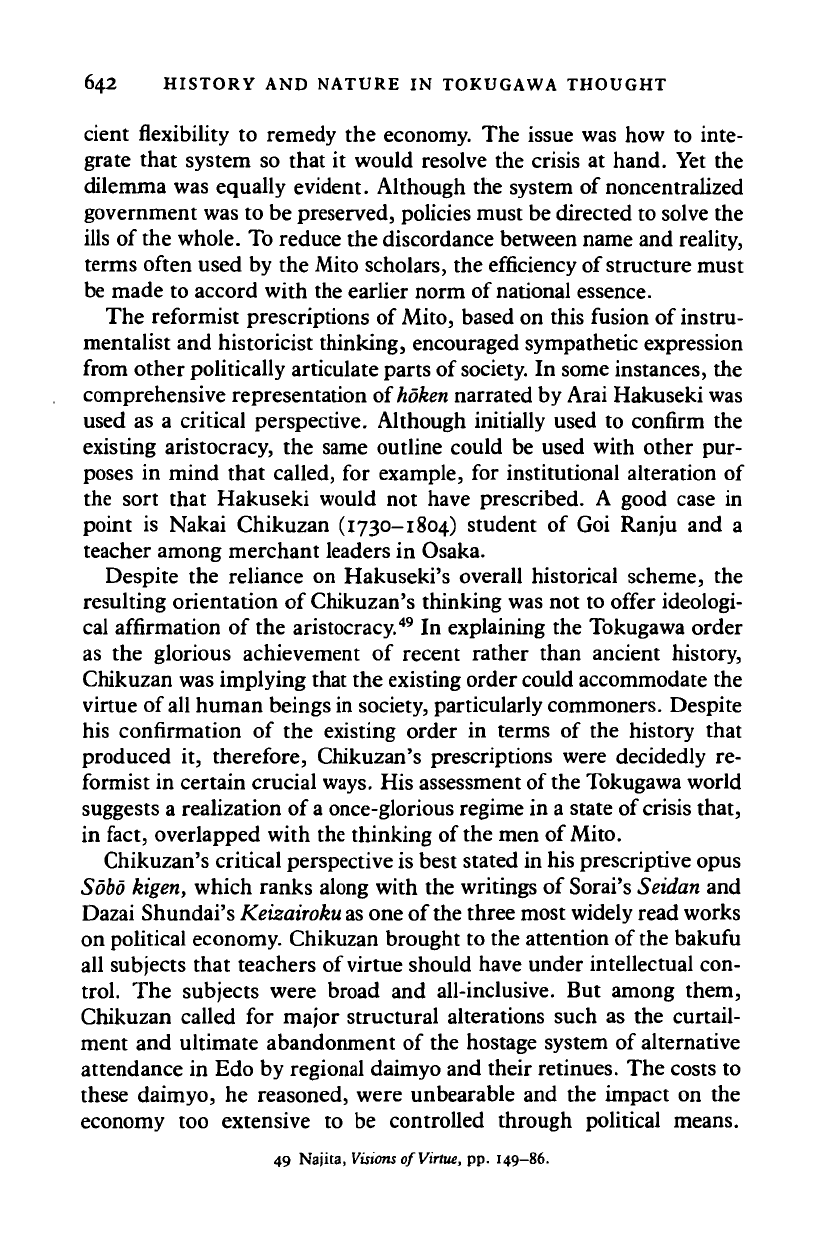
642 HISTORY AND NATURE IN TOKUGAWA THOUGHT
cient flexibility to remedy the economy. The issue was how to inte-
grate that system so that it would resolve the crisis at hand. Yet the
dilemma was equally evident. Although the system of noncentralized
government was to be preserved, policies must be directed to solve the
ills of the whole. To reduce the discordance between name and reality,
terms often used by the Mito scholars, the efficiency of structure must
be made to accord with the earlier norm of national essence.
The reformist prescriptions of
Mito,
based on this fusion of instru-
mentalist and historicist thinking, encouraged sympathetic expression
from other politically articulate parts of
society.
In some instances, the
comprehensive representation of
hoken
narrated by Arai Hakuseki was
used as a critical perspective. Although initially used to confirm the
existing aristocracy, the same outline could be used with other pur-
poses in mind that called, for example, for institutional alteration of
the sort that Hakuseki would not have prescribed. A good case in
point is Nakai Chikuzan (1730-1804) student of Goi Ranju and a
teacher among merchant leaders in Osaka.
Despite the reliance on Hakuseki's overall historical scheme, the
resulting orientation of Chikuzan's thinking was not to offer ideologi-
cal affirmation of the aristocracy.
49
In explaining the Tokugawa order
as the glorious achievement of recent rather than ancient history,
Chikuzan was implying that the existing order could accommodate the
virtue of
all
human beings in society, particularly commoners. Despite
his confirmation of the existing order in terms of the history that
produced it, therefore, Chikuzan's prescriptions were decidedly re-
formist in certain crucial ways. His assessment of the Tokugawa world
suggests a realization of
a
once-glorious regime in a state of
crisis
that,
in fact, overlapped with the thinking of the men of Mito.
Chikuzan's critical perspective is best stated in his prescriptive opus
Sobo
kigen,
which ranks along with the writings of Sorai's
Seidan
and
Dazai Shundai's
Keizairoku as
one of the three most widely read works
on political economy. Chikuzan brought to the attention of the bakufu
all subjects that teachers of virtue should have under intellectual con-
trol. The subjects were broad and all-inclusive. But among them,
Chikuzan called for major structural alterations such as the curtail-
ment and ultimate abandonment of the hostage system of alternative
attendance in Edo by regional daimyo and their retinues. The costs to
these daimyo, he reasoned, were unbearable and the impact on the
economy too extensive to be controlled through political means.
49 Najita, Visions of
Virtue,
pp. 149-86.
Cambridge Histories Online © Cambridge University Press, 2008
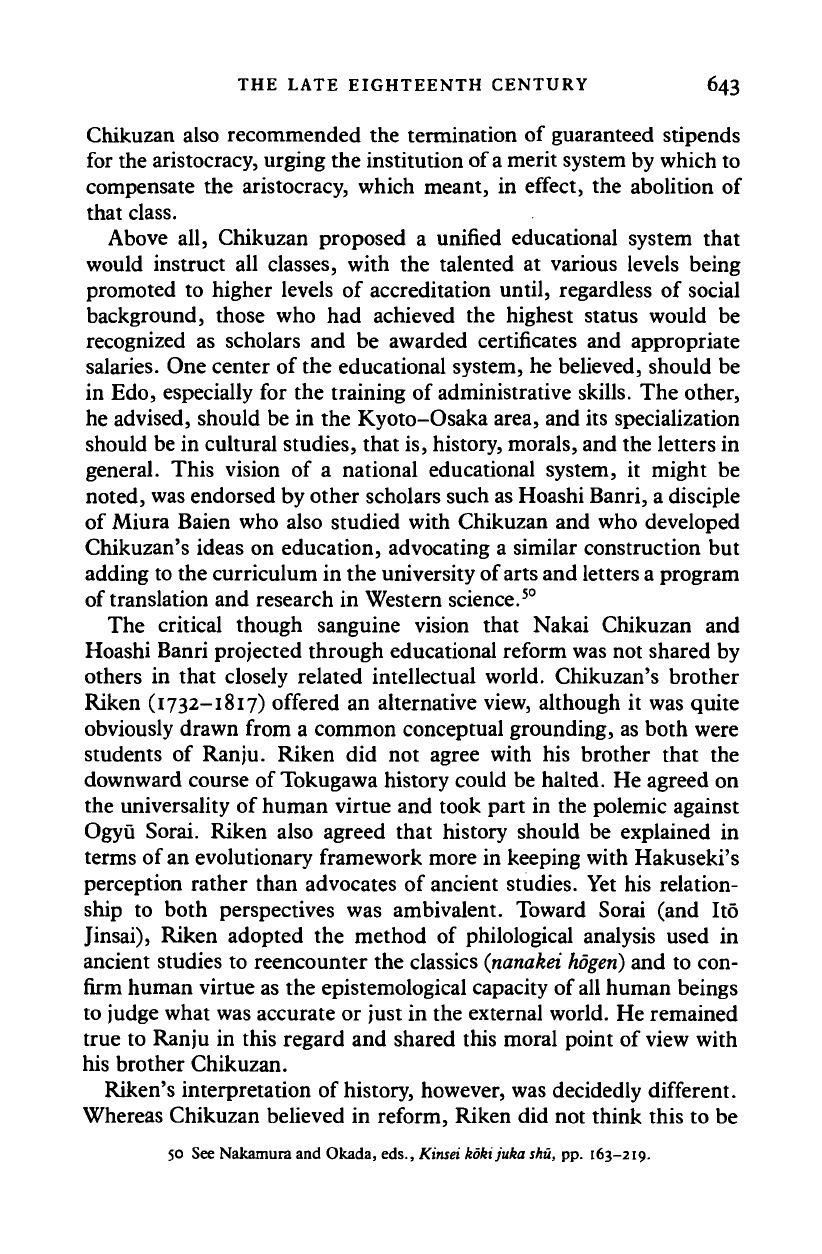
THE LATE EIGHTEENTH CENTURY 643
Chikuzan also recommended
the
termination
of
guaranteed stipends
for the aristocracy, urging the institution of a merit system by which to
compensate
the
aristocracy, which meant,
in
effect,
the
abolition
of
that class.
Above
all,
Chikuzan proposed
a
unified educational system that
would instruct
all
classes, with
the
talented
at
various levels being
promoted
to
higher levels
of
accreditation until, regardless
of
social
background, those
who had
achieved
the
highest status would
be
recognized
as
scholars
and be
awarded certificates
and
appropriate
salaries. One center
of
the educational system,
he
believed, should
be
in Edo, especially
for
the training
of
administrative skills. The other,
he advised, should be
in the
Kyoto-Osaka area, and its specialization
should be
in
cultural studies, that is, history, morals, and the letters
in
general. This vision
of a
national educational system,
it
might
be
noted, was endorsed by other scholars such as Hoashi Banri, a disciple
of Miura Baien who also studied with Chikuzan
and
who developed
Chikuzan's ideas
on
education, advocating
a
similar construction
but
adding to the curriculum in the university of arts and letters a program
of translation and research
in
Western science.
50
The critical though sanguine vision that Nakai Chikuzan
and
Hoashi Banri projected through educational reform was not shared
by
others
in
that closely related intellectual world. Chikuzan's brother
Riken (1732-1817) offered
an
alternative view, although
it
was quite
obviously drawn from
a
common conceptual grounding, as both were
students
of
Ranju. Riken
did not
agree with
his
brother that
the
downward course
of
Tokugawa history could be halted. He agreed on
the universality
of
human virtue and took part
in
the polemic against
Ogyu Sorai. Riken also agreed that history should
be
explained
in
terms of an evolutionary framework more
in
keeping with Hakuseki's
perception rather than advocates
of
ancient studies. Yet
his
relation-
ship
to
both perspectives
was
ambivalent. Toward Sorai
(and Ito
Jinsai),
Riken adopted
the
method
of
philological analysis used
in
ancient studies
to
reencounter the classics
(nanakei hogen)
and
to
con-
firm human virtue as the epistemological capacity
of
all
human beings
to judge what was accurate
or
just
in
the external world. He remained
true
to
Ranju
in
this regard
and
shared this moral point
of
view with
his brother Chikuzan.
Riken's interpretation
of
history, however, was decidedly different.
Whereas Chikuzan believed
in
reform, Riken
did not
think this
to be
50 See Nakamura and Okada, eds.,
Kinsei
kokijuka
shu,
pp. 163-219.
Cambridge Histories Online © Cambridge University Press, 2008

644 HISTORY AND NATURE IN TOKUGAWA THOUGHT
possible. Riken used the evolutionary framework to disagree with
what the previous generation, including Chikuzan, had said, namely,
that the history of the previous five hundred years had resulted in the
virtuous Tokugawa regime. In Riken's eyes, that same evolutionary
history revealed
a
consistent pattern of deceit, the unwarranted usurpa-
tion of legitimate kingly authority, and steady decline. Having read the
Mito school's "Great History," Riken could not reconcile this account
with the broad representation of the present as the inevitable outcome
of the past. The decline of justice over that long history was not
inevitable but attributable to passionate warlords seeking power
against the imperial center that sought peace and tranquility for the
populace. Although Riken retained intact the evolutionary perspec-
tive,
he had sharply altered the interpretive intent into an indictment
of received history. The Tokugawa shogunate could now be framed as
the culmination of a vast conspiracy and incessant betrayal. Riken's
pessimism led him to withdraw from political society and to lead a life
as a scholarly recluse.
51
Riken was not alone in reinterpreting history in this harsh manner.
A near contemporary, Yamagata Daini (1725-67) had taken this alter-
native scheme and shaped a theory of rebellion against the bakufu
itself.
52
History revealed, for Daini, treachery by ambitious men,
whose manifestation in the present was the privileged aristocracy. As a
class that depended on the sword, it retained the norms of emergent
military rule to govern society in inappropriately brutal ways. Gover-
nance in times of peace should rest on cultural means, which required
that the aristocracy be dismantled and returned to the soil and new
talent from below recognized.
The key issue that Daini addressed was that of action. If the injus-
tices received from history were perpetuated through systemic proce-
dures and power and were enforced as legitimate law, how should
moral men of knowledge proceed? Dazai Shundai had raised this ques-
tion too and had advised that the sage had no choice but to do nothing
and let the system falter and collapse on its own. Daini did not believe
that the existing order would allow such an ignominious fate and that
injustices backed up by the force of law would persist. Rather than do
nothing, therefore, the sage must meet power with power. Curiously,
Shundai himself had discussed this alternative in connection with the
51 I
have
written
about Riken
in
Visions
of
Virtue,
pp. 186-221.
52 See
Ichii
Saburo,
Meiji ishin
no
tetsugaku
(Tokyo:
Kodansha,
1967),
pp. 33-53; and my
"Restorationism
in the
Political
Thought
of
Yamagata Daini
(1725-67),"
Journal
of
Asian
Studies
si
(1971):
17-29.
Cambridge Histories Online © Cambridge University Press, 2008
